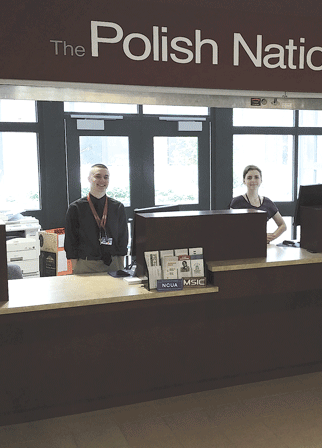
Wealth of Knowledge
Banks, Schools, Colleges Team Up to Boost Financial Literacy

Roosevelt Charles says financial-literacy programs at STCC help level the playing field for students in need.
“Thirty-five percent of households in Massachusetts have less than three months’ worth of savings, and 48% of Massachusetts consumers have subprime credit,” she said, citing a study conducted by the Corporation for Enterprise Development. “These statistics show that we have a real problem, and they illustrate the need for financial education.”
Furthermore, said Warren, vice president of marketing at Monson Savings Bank, “it’s worth noting how these statistics work together to create a cycle of debt and worsen financial insecurity. If someone with less than three months of savings faces an unforeseen expense, such as a broken-down car or a medical bill, they have to borrow to cover the tab. If that person also has subprime credit, the only option may be to take out a high-cost — often predatory — loan. It’s difficult for them to get a loan at an affordable rate.”
As a community bank, Monson has encountered many people in just that circumstance. While life’s circumstances are different for everyone, Warren said, many of them graduated from school and entered adult life without truly understanding the importance of credit, debt, savings, and many other facets of finance.
That’s why MSB is one of many area banks that have teamed with schools to reach young people with lessons in how to handle money.
“By teaching financial literacy in the schools, we can teach kids early how to become better savers, spenders, and money managers — so that, maybe, they won’t find themselves in that situation,” she said.
During the annual Statewide Summit on Financial Education — staged recently at the UMass Center at Springfield and sponsored by the financial-education coalition MassSaves — state Treasurer Deb Goldberg, the event’s keynote speaker, talked about how today’s students don’t grow up with the same exposure to financial education as she did, and how it needs to be reintroduced in public schools, as early as the primary grades.
“I believe we can embed into the curriculum financial skills that kids will need,” she said, recalling the bank passbook she received as a child. “Once in a while, my parents would drive me to an actual bank so I could see what’s going on. That’s how you learn. Kids today can program any iPhone, download any app, but ask them to look at these pieces of money and explain to me a penny, nickel, quarter, they can’t do that. It’s fascinating. My feeling is, let’s step back and start with the basics again.”
Polish National Credit Union has a well-established branch at Chicopee Comprehensive High School that doubles as a way to help students — both those who use it and those who work there as part of their education — learn about finance.
“We employ students — we go through the process just as if they’re going to apply here at the main office — and we train them,” said Jennifer Gallant, the credit union’s chief financial officer.
“Then, once the summer comes and the school branch is closed, we bring the employees over here as summer interns,” she continued. “A lot of the students who have worked at the school branch have enjoyed it and stayed on with us in a greater capacity when we’ve had openings at other branches. Some have even gone on to finance in college.”
Even for students who are casually exposed to the Chicopee Comp branch, she told BusinessWest, “it’s an eye-opener to how finance and banking works. I think it also helps encourage all of the kids in the school to at least look into a savings account, a checking account, what else the credit union has to offer, and how it benefits them — to get them on the right road economically.”
Between efforts like the summit — which drew representatives from many banks, schools, colleges, and financial-education organizations — and efforts by community banks and nonprofit entities to reach out to both students and adults, increasing focus is being placed on the broad issue of financial literacy.
After all, “when we talk about financial literacy and educating kids about what they need to understand these decisions they will be making, we are creating an economic foundation in the state that is stable, breaking down inequality,” Goldberg noted. “Through financial education, we see that, when we invest in people, we’re empowering people to invest in themselves.”
Education for Life
It’s not just happening at the K-12 level, said Kelly Goss, associate director of the Midas Collaborative, a statewide organization that focuses on financial literacy and connecting people with a range of financial resources.
“Our bread and butter is our matched savings account programs,” she noted, referring to a number of different programs that, in partnership with public and private organizations, provide low-income individuals with savings accounts and match their contributions. Clients generally use the funds for one of three purposes: home buying, small-business development, or post-secondary education.

Chicopee Comp students Chad LePage and Ludmila Kaletin work as tellers in the school’s Polish National Credit Union branch.
During the one- to two-year period of the matched savings program, the students also join peer groups, attend workshops, and participate in individual coaching sessions to build their financial skills, rectify financial issues, learn about the economy, and engage them in planning for the future.
“Students receiving the matched savings are required to take eight hours of finance education outside of their course work,” Goss said. “The school provides workshops — teaching them what is credit, what is debt, what is the significance of having a bank account? Some of these students have never had a bank account before.”
Roosevelt Charles, director of access and student services at STCC, said the college ramped up its financial-literacy initiatives — including its partnership with the Midas Collaborative — about a year and a half ago, when administrators noticed students dropping out for financial reasons, who didn’t have the knowledge to access different public benefits or navigate the financial arena, period.
“We’ve done a few other things to level the playing field as related to financial literacy,” he added. “We collaborate with Single Stop USA, a national community-college initiative that provides space on campus where students can go for a variety of public and community benefits. Students can apply for food assistance, housing, fuel assistance — all these benefits, all those resources, in one area. We do have a large percentage of students seeking those benefits.”
The school has also teamed up with MassMutual through that corporation’s LifeBridge program, which offers free term life insurance to families in need. These programs and others, Charles said, represent an effort to offer students both tangible financial resources and education and guidance in putting them to use.
“Once we get students talking about their knowledge — or lack thereof — as related to accessing resources, they realize there are other things out there — ‘did you know MassMutual is offering free life insurance?’ It’s amazing for us; we didn’t expect to get this granular in terms of community support. But, over past two semesters, these conversations have motivated us to go back out into the community and seek out additional resources to offer.”
On the state level, Goldberg said, the recently created Office of Economic Empowerment, led by Deputy Treasurer Alayna Van Tassel, is seeking to create more such partnerships between the state, schools, and businesses. Goals include expansion of Credit for Life fairs and more matched college savings accounts like those pioneered by Midas.
Goldberg said studies have found clear correlations between financial literacy at a young age and college enrollment, or vocational or technical training, after high school.
“Why is that important here in Massachusetts? Well, where is our economy? Biotech, high tech, higher education, healthcare — so we need to make opportunities available to kids,” she explained. “If we provide opportunities to educate, kids will seize upon it.”
Breaking Barriers
In short, Goldberg claimed, financial literacy may be the key ingredient to financial stability across Massachusetts, because it affects so many areas of life.
“All the work we do around teaching kids, teaching women, teaching veterans how to empower themselves is not a partisan issue; it’s an issue that creates opportunities for folks, and candidly, if we can empower people to take care of themselves, they don’t need [as many] safety nets,” she told the summit attendees. “Financial challenges impact every one of us — children to adults, students, teachers, advocates, and policy makers.”
MassSaves, which was created in 2011, complements its work in schools and colleges with financial trainings — “train the trainer” sessions, Goss called them — with the United Way and other community-based organizations that deliver financial-education services. But it all starts with those outreaches into schools.
“The reality is, we need financial education to be taught at every level,” she said. “We want to see it in the curriculum as early as possible, so people grow up with it as an early tool, like math. Why would you not? Particularly in this day and age, it’s really difficult to function without a knowledge of finance and access to a bank account. It’s certainly a barrier for those who don’t have that access.”
Warren, who serves on the steering committee of MassSaves, said Monson Savings Bank became a strategic partner with the organization a little over a year ago, in an effort to help members of the community become more financially confident and capable.
“Here at the bank, we do have people coming through the doors on occasion who can’t get a loan, who may not even be able to get a checking account because they have outstanding balances with other banks,” she told BusinessWest. “That’s why we’ve gotten involved in this. We’re a community bank, which means we’re here to help the community, and we want to help everyone who comes through our doors.”
Now, the bank can direct those customers to MassSaves, which can hook them up with a financial coach by phone, e-mail, or Skype, and connect them to other financial resources they might require.
“It’s definitely needed, and that’s why we’re working on this issue in this manner, in this broad collaboration with lots of different partners,” Warren said. “Really, the more, the merrier. Everything we do collectively is a positive thing.”
Starting with a child’s first introduction to pennies, nickels, and quarters.
Joseph Bednar can be reached at [email protected]






